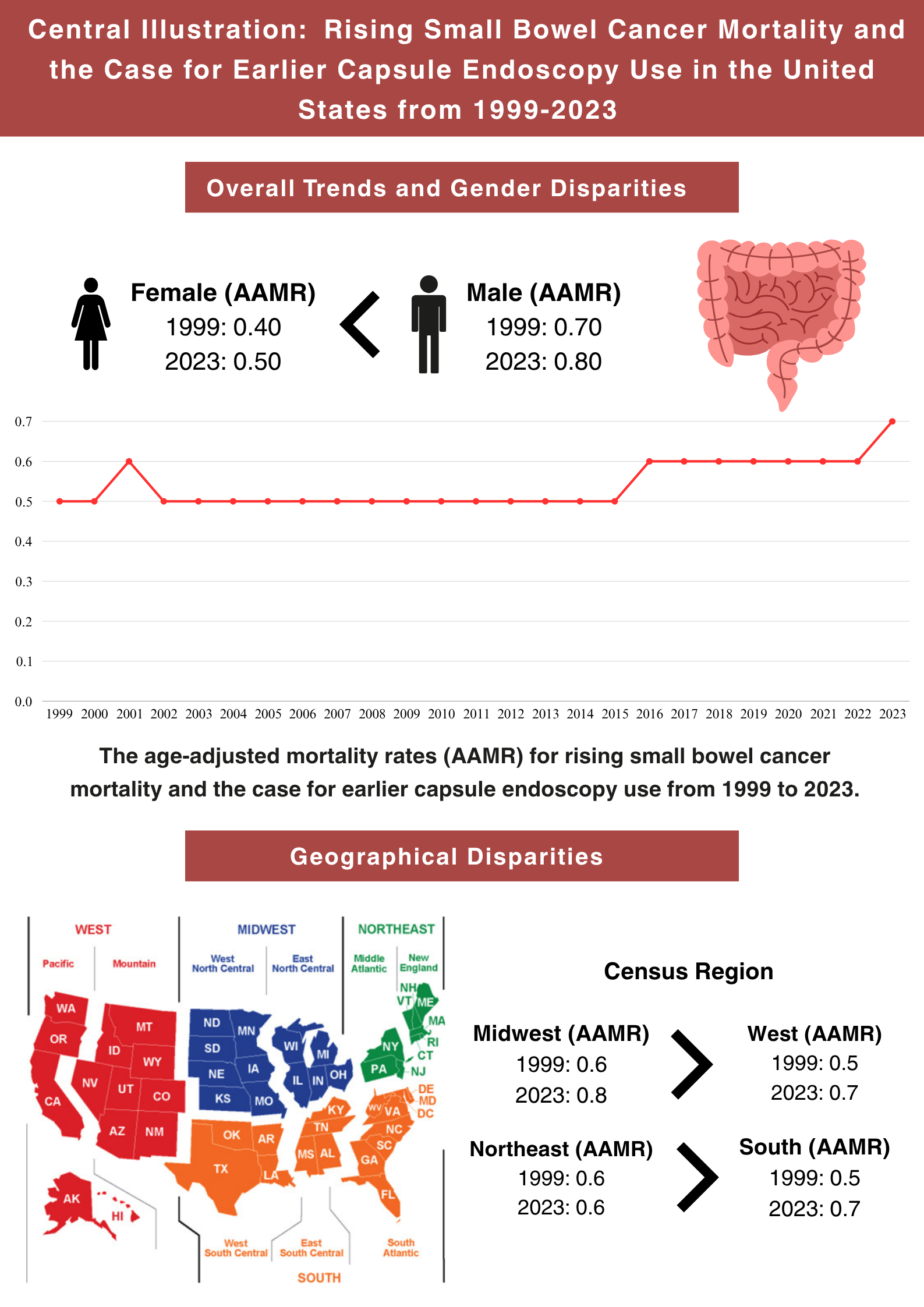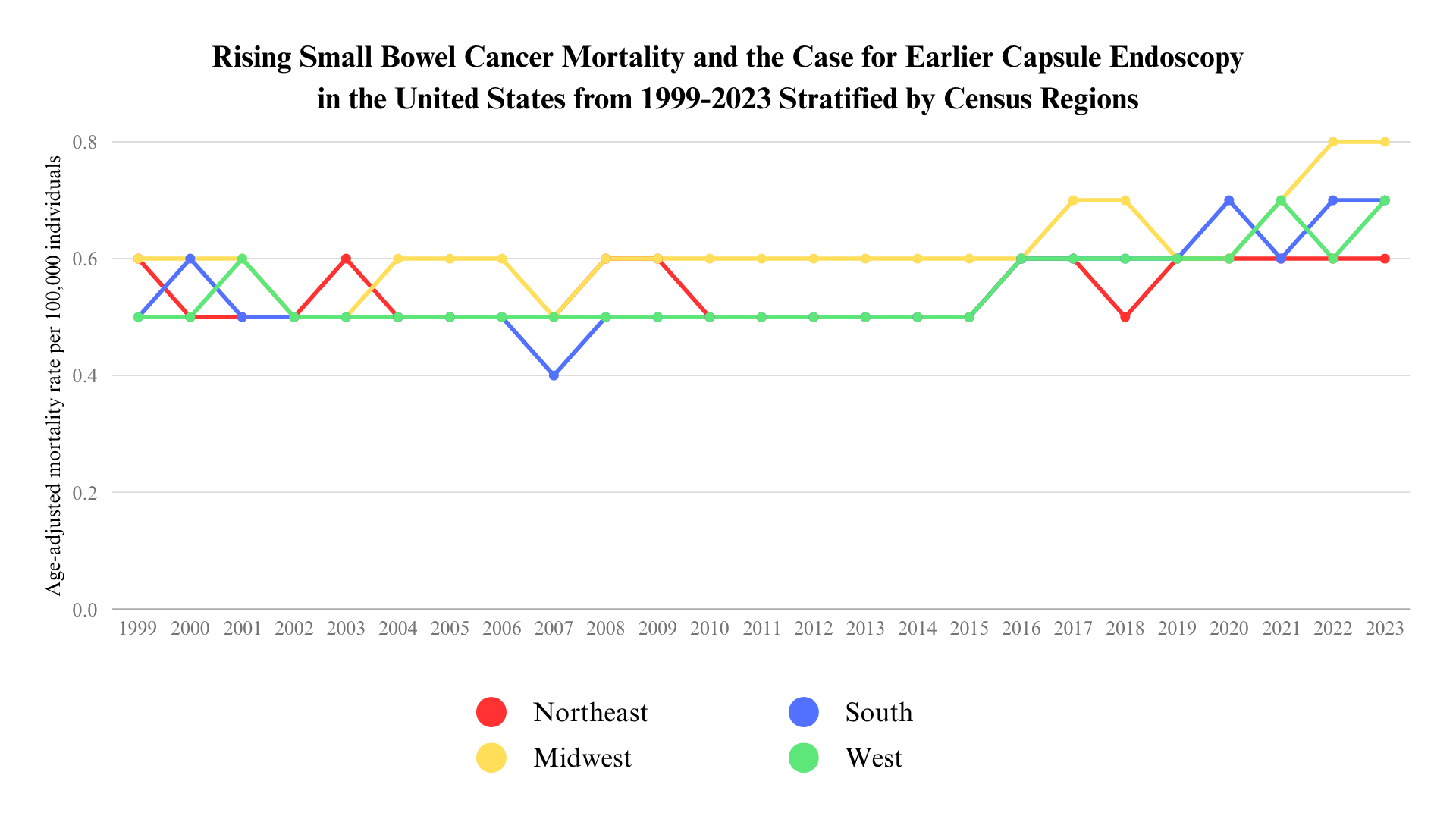Monday Poster Session
Category: Small Intestine
P4067 - The Diagnostic Gap: Rising Small Bowel Cancer Mortality and the Case for Earlier Capsule Endoscopy Use
Monday, October 27, 2025
10:30 AM - 4:00 PM PDT
Location: Exhibit Hall

Rahul Kumar, MD (he/him/his)
North Central Bronx Hospital
Bronx, NY
Presenting Author(s)
Rahul Kumar, MD1, Avinash Nankani, MBBS2, Zoya Aamir, MBBS3, Sunny Kumar, MD4, Tahreem Mari, MBBS3, Diksha Kajal, MD5, Karan J.. Yagnik, MD6, Vikash Kumar, MD7, Miroslav Radulovic, MD1
1North Central Bronx Hospital, Bronx, NY; 2Dow University of Health Sciences, Karachi, Sindh, Pakistan; 3Dow Medical College, Karachi, Sindh, Pakistan; 4Wright Center for Graduate Medical Education, Scranton, PA; 5Florida State University, Cape Coral, FL; 6Monmouth Medical Center, Robert Wood Johnson Medical School of Rutgers University, Long Branch, NJ; 7Creighton University School of Medicine, Phoenix, AZ
Introduction: Small bowel cancer (SBC) is a rare gastrointestinal malignancy comprising only 0.6% of new cancer cases in the US that has historically been diagnosed late, resulting in poor prognosis, as the small bowel is a vast organ with a highly proliferative epithelium. Recent trends indicate rising mortality rates in the United States, potentially due to diagnostic delays, due to the nonspecific nature of presenting symptoms, despite advances in imaging technology such as capsule endoscopy.
Methods: We evaluated temporal trends in small bowel cancer mortality across the U.S. and explored the diagnostic gap that could be addressed by earlier use of capsule endoscopy. This retrospective, population-based study used publicly available mortality data from the CDC WONDER database, stratified by sex and U.S. Census regions. Trends in age-adjusted death rates per 100,000 individuals from 1999 to 2023 were analyzed, focusing on cases coded under ICD-10: C17. Analysis focused on diagnosis and management patterns of small bowel cancer, particularly focusing on delayed detection and the underuse of capsule endoscopy. Annual age-adjusted mortality rates of small bowel cancer across demographic groups and geographic regions, and statistical trend analysis were used to assess changes in mortality over time and evaluate disparities by sex and location.
Results: From 1999 to 2023, small bowel cancer mortality increased across nearly all U.S. Census regions in an AAMR from 0.5 to 0.7, with the highest age-adjusted death rates observed from 1999 to 2023 in the South (overall AAMR: 0.5). From 1999 to 2023, males consistently exhibited higher mortality rates than females, with an AAMR of 0.7 in 1999 and 0.8 in 2023 for males and 0.4 in 1999 and 0.5 in 2023 for females. The data demonstrates a diagnostic gap, contributing to an increase in mortality. Despite being less invasive and more accessible, capsule endoscopy remains underutilized in early diagnostic pathways for small bowel cancer.
Discussion: This analysis highlights an alarming rise in small bowel cancer mortality and suggests a potential role for earlier capsule endoscopy use in bridging the diagnostic gap. Enhanced clinical awareness and guideline revisions are warranted to promote the timely evaluation of unexplained gastrointestinal symptoms and to establish a new diagnostic and therapeutic algorithm using balloon-assisted endoscopy and capsule endoscopy, potentially improving survival outcomes in this rare but deadly cancer.

Figure: Illustration

Figure: Census Region
Disclosures:
Rahul Kumar indicated no relevant financial relationships.
Avinash Nankani indicated no relevant financial relationships.
Zoya Aamir indicated no relevant financial relationships.
Sunny Kumar indicated no relevant financial relationships.
Tahreem Mari indicated no relevant financial relationships.
Diksha Kajal indicated no relevant financial relationships.
Karan Yagnik indicated no relevant financial relationships.
Vikash Kumar indicated no relevant financial relationships.
Miroslav Radulovic indicated no relevant financial relationships.
Rahul Kumar, MD1, Avinash Nankani, MBBS2, Zoya Aamir, MBBS3, Sunny Kumar, MD4, Tahreem Mari, MBBS3, Diksha Kajal, MD5, Karan J.. Yagnik, MD6, Vikash Kumar, MD7, Miroslav Radulovic, MD1. P4067 - The Diagnostic Gap: Rising Small Bowel Cancer Mortality and the Case for Earlier Capsule Endoscopy Use, ACG 2025 Annual Scientific Meeting Abstracts. Phoenix, AZ: American College of Gastroenterology.
1North Central Bronx Hospital, Bronx, NY; 2Dow University of Health Sciences, Karachi, Sindh, Pakistan; 3Dow Medical College, Karachi, Sindh, Pakistan; 4Wright Center for Graduate Medical Education, Scranton, PA; 5Florida State University, Cape Coral, FL; 6Monmouth Medical Center, Robert Wood Johnson Medical School of Rutgers University, Long Branch, NJ; 7Creighton University School of Medicine, Phoenix, AZ
Introduction: Small bowel cancer (SBC) is a rare gastrointestinal malignancy comprising only 0.6% of new cancer cases in the US that has historically been diagnosed late, resulting in poor prognosis, as the small bowel is a vast organ with a highly proliferative epithelium. Recent trends indicate rising mortality rates in the United States, potentially due to diagnostic delays, due to the nonspecific nature of presenting symptoms, despite advances in imaging technology such as capsule endoscopy.
Methods: We evaluated temporal trends in small bowel cancer mortality across the U.S. and explored the diagnostic gap that could be addressed by earlier use of capsule endoscopy. This retrospective, population-based study used publicly available mortality data from the CDC WONDER database, stratified by sex and U.S. Census regions. Trends in age-adjusted death rates per 100,000 individuals from 1999 to 2023 were analyzed, focusing on cases coded under ICD-10: C17. Analysis focused on diagnosis and management patterns of small bowel cancer, particularly focusing on delayed detection and the underuse of capsule endoscopy. Annual age-adjusted mortality rates of small bowel cancer across demographic groups and geographic regions, and statistical trend analysis were used to assess changes in mortality over time and evaluate disparities by sex and location.
Results: From 1999 to 2023, small bowel cancer mortality increased across nearly all U.S. Census regions in an AAMR from 0.5 to 0.7, with the highest age-adjusted death rates observed from 1999 to 2023 in the South (overall AAMR: 0.5). From 1999 to 2023, males consistently exhibited higher mortality rates than females, with an AAMR of 0.7 in 1999 and 0.8 in 2023 for males and 0.4 in 1999 and 0.5 in 2023 for females. The data demonstrates a diagnostic gap, contributing to an increase in mortality. Despite being less invasive and more accessible, capsule endoscopy remains underutilized in early diagnostic pathways for small bowel cancer.
Discussion: This analysis highlights an alarming rise in small bowel cancer mortality and suggests a potential role for earlier capsule endoscopy use in bridging the diagnostic gap. Enhanced clinical awareness and guideline revisions are warranted to promote the timely evaluation of unexplained gastrointestinal symptoms and to establish a new diagnostic and therapeutic algorithm using balloon-assisted endoscopy and capsule endoscopy, potentially improving survival outcomes in this rare but deadly cancer.

Figure: Illustration

Figure: Census Region
Disclosures:
Rahul Kumar indicated no relevant financial relationships.
Avinash Nankani indicated no relevant financial relationships.
Zoya Aamir indicated no relevant financial relationships.
Sunny Kumar indicated no relevant financial relationships.
Tahreem Mari indicated no relevant financial relationships.
Diksha Kajal indicated no relevant financial relationships.
Karan Yagnik indicated no relevant financial relationships.
Vikash Kumar indicated no relevant financial relationships.
Miroslav Radulovic indicated no relevant financial relationships.
Rahul Kumar, MD1, Avinash Nankani, MBBS2, Zoya Aamir, MBBS3, Sunny Kumar, MD4, Tahreem Mari, MBBS3, Diksha Kajal, MD5, Karan J.. Yagnik, MD6, Vikash Kumar, MD7, Miroslav Radulovic, MD1. P4067 - The Diagnostic Gap: Rising Small Bowel Cancer Mortality and the Case for Earlier Capsule Endoscopy Use, ACG 2025 Annual Scientific Meeting Abstracts. Phoenix, AZ: American College of Gastroenterology.
